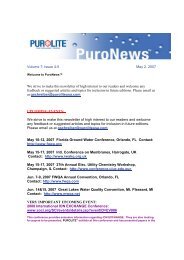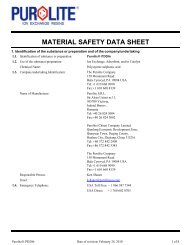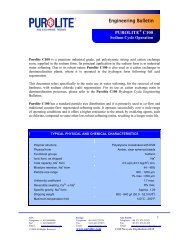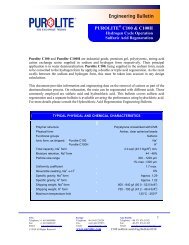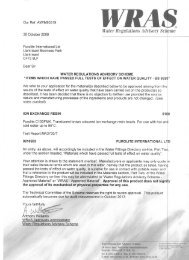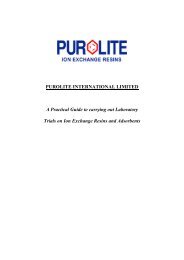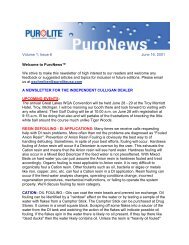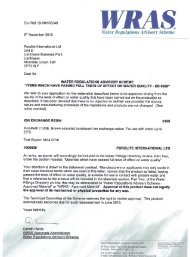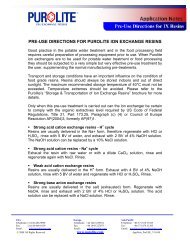Counter-flow regeneration - Purolite
Counter-flow regeneration - Purolite
Counter-flow regeneration - Purolite
Create successful ePaper yourself
Turn your PDF publications into a flip-book with our unique Google optimized e-Paper software.
The slow (regenerant displacement) rinse is always carried out at <strong>flow</strong> rates similar to the acid<br />
injection step. This is to ensure a uniform contact time between the resin and the regenerant<br />
solution and that the rinse water follows the same route of the regenerant through the resin bed.<br />
Since slow rinses are usually more efficient in removing the spent regenerant from the resin, using<br />
a longer slow rinse can reduce the amount of final rinse required at the end of the <strong>regeneration</strong>.<br />
Normally 1 to 3 BV (7.5 to 22.5 gal/ft 3 ) of slow rinse are applied.<br />
The final rinse is often carried out at the service <strong>flow</strong> rate. This also acts as a proving condition<br />
prior to returning to service after <strong>regeneration</strong>. On some occasions, where <strong>flow</strong> restrictions occur,<br />
the plant final rinse is carried out at a rate lower than the service <strong>flow</strong> rate. Normally 3 to 6 BV<br />
(22.5 to 45 gal/ft 3 ) are required depending on the design of the distribution / collection systems<br />
and the amount of slow rinsing previously performed.<br />
<strong>Counter</strong>-<strong>flow</strong> <strong>regeneration</strong><br />
Traditional counter-<strong>flow</strong> <strong>regeneration</strong> techniques normally have less steps than those described<br />
earlier for co-<strong>flow</strong> <strong>regeneration</strong> and typically take between 1 and 1½ hours depending on the<br />
detailed design. This type of <strong>regeneration</strong> requires, for some steps, the use of cation free water.<br />
Decationized or demineralized water must be used for the acid dilution / injection and slow rinse<br />
steps, if the published leakage is to be obtained. The water is either set aside during the previous<br />
service run or, in case of multi stream plants, it can be supplied by one of the other on-line<br />
streams. When decationized water is stored for <strong>regeneration</strong>, some plants use a dedicated tank, but<br />
when a degassing tower is part of the process, the degassing tower sump is normally used for this<br />
duty. When demineralized water is used, then the client’s treated water tank or a separate tank are<br />
employed.<br />
In a counter-<strong>flow</strong> regenerated system, the backwash step, which is always the first step of a co<strong>flow</strong><br />
<strong>regeneration</strong>, is not normally performed each cycle, but a means of carrying out periodic full<br />
bed backwashes, either inside the service unit or in external dedicated vessels, should always be<br />
included in the plant design. Some engineering designs allow for sub-surface backwashes to be<br />
carried out each cycle, but such partial backwashes should not be intended as a replacement of<br />
periodic full bed backwashes. After a full bed backwash the resin should always be regenerated<br />
with double the normal amount of acid to restore full counter-<strong>flow</strong> performance.<br />
In counter-<strong>flow</strong> <strong>regeneration</strong> bed depths below 1000 mm (3 ft 3 in) should be avoided and<br />
preferably beds in excess of 1200 mm (4 ft) employed.<br />
The <strong>regeneration</strong> level (amount of acid applied per litre or cubic foot of resin) will be lower than<br />
for co-<strong>flow</strong> regenerated units, typically between 40 and 80 g/l (2.5 – 5 lbs/ft 3 ). However,<br />
<strong>regeneration</strong> levels outside of this range are sometimes employed.<br />
Hydrochloric acid should be introduced at <strong>flow</strong> rates of 2 to 4 BV/h (0.25 to 0.5 gpm/ft 3 ) and<br />
concentrations from 4 to 6%. The contact time between the resin and the regenerant solution<br />
should be minimum 20 minutes.<br />
USA Europe Asia Pacific<br />
6<br />
Telephone: +1 610 6689090 Telephone: +44 1443 229334 Telephone: +86 571 876 31382<br />
Fax: +1 610 6688139 Fax: +44 1443 227073 Fax: +86 571 876 31385<br />
Email: info@puroliteusa.com Email: sales@purolite.com Email: puroliteasia@purolitechina.com<br />
© 2010 All Rights Reserved www.purolite.com C100 (HCl) Eng Bulletin 0910





